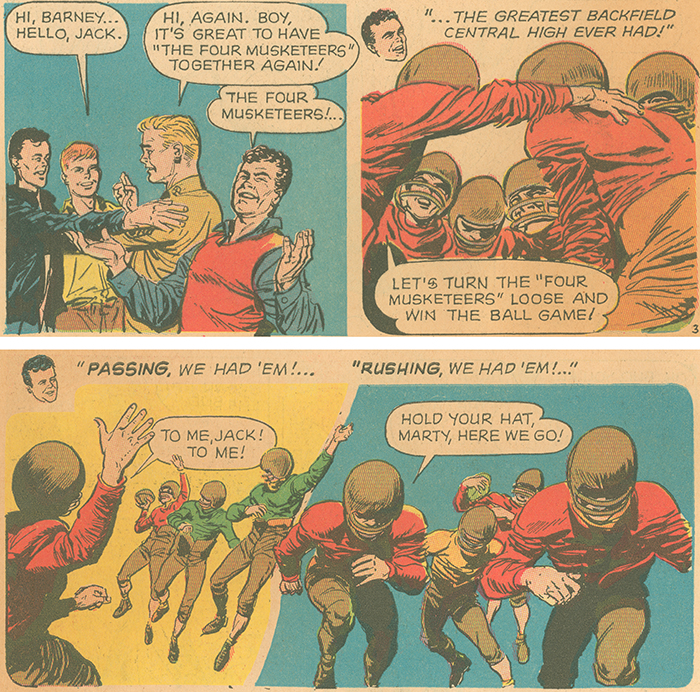The comic Five Years Later…Where Will You Be? is a 1962 Army recruiting publication that was heavily invested in the masculine Be a Big Wheel concept.[^] The comic primarily did so through the protagonist, Bud, who used the Army to ensure a secure financial future, and won back his girl, Mary Lou, in the process. At the beginning of the comic, Bud is immature, and unsure of his future, and it is causing problems with Mary Lou. Bud spoke with Jack, his older brother, and his friends, who helped him make some serious decisions about his financial future. They all share their stories with Bud. Then men are seen as mature and developed role models, although one had been off track and was using the military to get back on track. Three of the four men served in the military, and the other is about to leave for training.
Although the men they haven’t talked much, if at all, over the last four years, they made fast friends once again, uniting behind their collective nickname, “The Four Musketeers,” and sharing stories about their time in the service.[^] They went on to talk about how they composed ”…the greatest backfield central high ever had!” and relived their glory days of high school football.[^] Their experience as athletes, and successful ones at that, served as a common bond between them, and provided them with an identity and reputation.
The athletic ability and the prestige of these men is further supported and legitimated when the boys’ basketball coach met with their guidance counselor. The coach told him, “You know, as guidance counselor, you could honestly recommend professional ball to a few of those boys…especially Jack and Barney.”[^] Jack and Barney then spoke with the counselor, who advised them to get their military obligation behind them, and they joined the military right away.
In the process of catching up, the Four Musketeers also engaged in competition by bowling. Though it is not highly physical in nature, they give each other a hard time and joke around in a competitive spirit, even placing a very small bet on the game. The two men in the Army that are currently enlisted win, prompting one of the men on the losing squad to quip, “At least it took the U.S. Army to bowl us over!” supporting the idea that, as currently enlisted soldiers, they would be naturally better, or that they carry an elevated status.[^]
The most striking aspect of this comic in regard to sports and the Big Wheel idea is the cover art chosen to go with the comic. Although the story revolves around Bud’s relationship with Mary Lou and his decision to join the military, the front cover features Jack, in full military uniform, bowling. Everyone else is watching excitedly, and Jack is clearly in alpha male form. Even more curiously, Bud is not pictured, and Mary Lou and another female (who never appears in the comic) are pictured watching Jack bowl. The cover art is instead a picture that situates Jack as the alpha male, and is only tangentially (and partially fictionally) related to the story. The front cover conveys a uniformed man’s Big Wheel status though his participation in competition and the social dynamic of others looking on admirably.
Related Sections
- Be a Big Wheel
- Be a Big Wheel - Athletic & Physical Prowess
- Be a Big Wheel - Athletic & Physical Prowess - It's All in the Family!
- Be a Big Wheel - Athletic & Physical Prowess - At the Ramparts
- Be a Big Wheel - Athletic & Physical Prowess - Dick Wingate in the US Navy
- Be a Big Wheel - Athletic & Physical Prowess - Look After My Billy!
- Be a Big Wheel - Athletic & Physical Prowess - Mister Marine Corps
- Be a Big Wheel - Athletic & Physical Prowess - Spirit of Semper Fi
- Be a Big Wheel - Athletic & Physical Prowess - US Air Force Academy
- Be a Bigwheel - Breadwinner - Five Years Later...Where Will You Be?
Primary Sources
Secondary Sources



